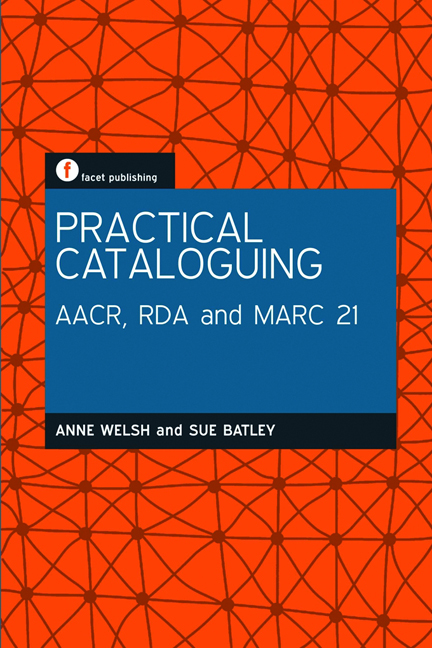Book contents
- Frontmatter
- Dedication
- Contents
- Acknowledgements
- Preface
- 1 Catalogues and cataloguing standards
- 2 The FRBRization of the catalogue
- 3 Bibliographic elements
- 4 Access points and headings
- 5 RDA: resource description and access
- 6 AACR and RDA
- 7 MARC 21
- 8 Practical cataloguing: bringing it all together
- 9 The birth of RDA and the death of MARC?
- 10 Examples
- References
- Index
Preface
Published online by Cambridge University Press: 08 June 2018
- Frontmatter
- Dedication
- Contents
- Acknowledgements
- Preface
- 1 Catalogues and cataloguing standards
- 2 The FRBRization of the catalogue
- 3 Bibliographic elements
- 4 Access points and headings
- 5 RDA: resource description and access
- 6 AACR and RDA
- 7 MARC 21
- 8 Practical cataloguing: bringing it all together
- 9 The birth of RDA and the death of MARC?
- 10 Examples
- References
- Index
Summary
This book has been three years in the making. It was commissioned to bridge the gap between John Bowman's Essential Cataloguing (last published before MARC revised its series fields from 440 and 490 to 490 alone) and Shawne Miksa's North American textbook on the new international cataloguing standard Resource Description and Access, to be published in the UK in 2013 (Miksa, n.d.).
It aims to meet the needs of two markets:
• those trained in cataloguing under AngloAmerican Cataloguing Rules 2nd Edition (AACR2) in need of a refresher, especially in the light of the new Standard
• those being trained in the current environment, when AACR2 is being phased out and the new standard is being phased in.
I use the verb ‘trained’ advisedly here. In the UK, there are few library schools that teach cataloguing in any detail. At the last comprehensive survey in 2005, University College London (UCL) was found to be the last in the UK with a compulsory module on cataloguing and classification, consisting of ten weeks of practical experience using AACR2 and several classification schema, which can be followed by an optional module ‘Advanced Cataloguing & Classification’.
This does not mean that cataloguing is completely absent from the UK's library schools. Many teach information architecture, incorporating a more theoretical knowledge. Students leave knowing what cataloguing is and how it aids information retrieval. They can recognize what a catalogue record looks like and have an understanding of the principles of knowledge organization. Practice in actual cataloguing – picking up a book (or other item), analysing it, describing it and providing access to it – is a little harder to come by.
Recent issues of CILIP's Catalogue & Index highlight the range of experience on library and information science (LIS) courses in 2011 (Carlton, 2011; Grim, 2011; Maule, 2011). Issue 162 includes an account by a student who spent three years at library school without, he says, cataloguing anything, but who actively sought volunteer experience outside university to learn how to catalogue (Carlton, 2011). In issue 163, a UCL student mentions a more theoretical course she took in the USA, and describes her determined and deliberate approach to gaining cataloguing experience – through taking the MA LIS at UCL and obtaining volunteer and paid work during her year in London (Howard, 2011).
Information
- Type
- Chapter
- Information
- Practical CataloguingAACR, RDA and MARC 21, pp. xiii - xviPublisher: FacetPrint publication year: 2012
